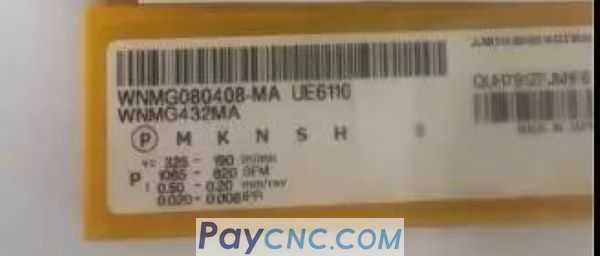When choosing a knife, many people tend to ignore the important information reflected on the blade box. In many cases, the information on the blade box can be used to determine the workpiece material, Vc, Fn, and Ap of the blade, so as to select the appropriate blade.
For example, there are two main types of workpiece materials reflected on the blade box: one is general-purpose blades; the other is special-purpose blades
One, general material blade
Some blade boxes are marked with three materials: P, M, and K. This type of blade is a general-purpose blade. Although the styles of the marks are different from each company, they represent the same meaning.
As shown in the figure: the black dots in the figure indicate the most suitable workpiece material, and the black circles indicate the suitable workpiece material.

2. Special material blade
In addition to general-purpose blades, the other is special-purpose blades, which are marked with only one workpiece material.
For example, many people always confuse the processing workpiece materials of CBN blades and PCD blades, because PCD blades contain C element, and ferrous metals such as steel and iron also contain C element. Therefore, PCD is suitable for processing non-ferrous metal materials and can be used for mirror processing. On the contrary, processing ferrous metals will accelerate the wear of PCD.

The 6 letters of P, M, K, N, S, and H on the blade box. Almost every blade box will have the logo of these letters. What do they mean?
Although the styles are not the same, the 6 letters of each company represent 6 different material groups. Which group of materials is indicated on the box represents which type of workpiece material the blade is suitable for processing.
According to ISO standards, workpiece materials are divided into 6 main groups, each of which has its own uniqueness in machinability.
steel
ISO P-Steel is the largest material group in the field of metal cutting, covering from non-alloy steel to cast steel, high-alloy materials, ferritic and martensitic stainless steels. Steel generally has good machinability, but it will vary greatly due to material hardness, carbon content, etc.
stainless steel
ISO M-Stainless steel is an alloy material that contains at least 12% chromium. Other alloys include nickel and molybdenum. Different material states such as ferrite, martensite, austenite, and austenite-ferrite (duplex) make stainless steel a broad material group. What all these types have in common is that the cutting edge generates a lot of heat during machining, prone to groove wear and buildup.
cast iron
ISO K-Unlike steel, cast iron is a short chip material. Grey cast iron (GCI) and malleable cast iron (MCI) are very easy to machine, while ductile iron (NCI), compacted graphite iron (CGI) and austempered ductile iron (ADI) are more difficult to machine. All cast irons contain silicon carbide (SiC), which can severely wear the cutting edge.
aluminum
ISO N-Non-ferrous metals are softer metals, such as aluminum, copper, brass, etc. Aluminum alloys with a silicon (Si) content of 13% are very abrasive. For inserts with sharp cutting edges, generally higher cutting speeds and longer tool life can be achieved.
Heat resistant alloy
ISO S-High-temperature alloys include many high-alloy iron, nickel, cobalt and titanium based materials. They are sticky and produce built-up edge, work hardening and heat. They are very similar to the ISO M group, but they are more difficult to cut, which results in a shorter cutting edge life.
Hardened steel
ISO H-This group includes steel with a hardness between 45-65 HRc and chilled cast iron with a hardness of about 400-600 HB. Due to the hardness, this group of materials is not easy to process. During the cutting process, these materials generate heat and severely wear the cutting edge.
|
 |
| Products Catalogue | Home | About Us | Retrofit | Download | News | Tech Support | Contact Us | |
|
|
|
